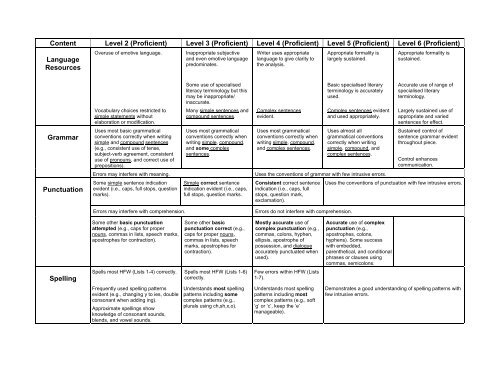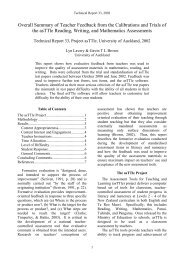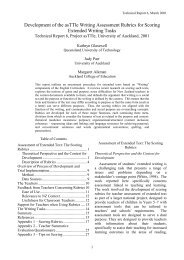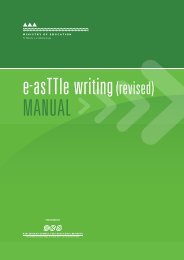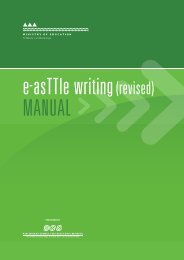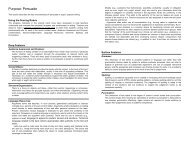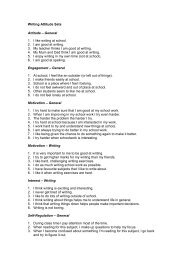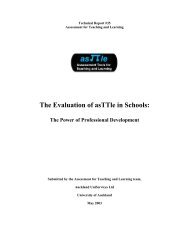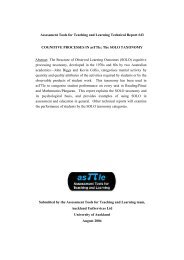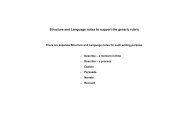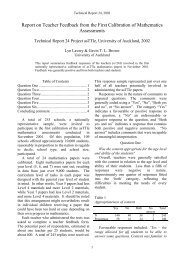Purpose: Analyse - e-asTTle
Purpose: Analyse - e-asTTle
Purpose: Analyse - e-asTTle
- No tags were found...
You also want an ePaper? Increase the reach of your titles
YUMPU automatically turns print PDFs into web optimized ePapers that Google loves.
Content Level 2 (Proficient) Level 3 (Proficient) Level 4 (Proficient) Level 5 (Proficient) Level 6 (Proficient)LanguageResourcesOveruse of emotive language.Inappropriate subjectiveand even emotive languagepredominates.Writer uses appropriatelanguage to give clarity tothe analysis.Appropriate formality islargely sustained.Appropriate formality issustained.Some use of specialisedliteracy terminology but thismay be inappropriate/inaccurate.Basic specialised literaryterminology is accuratelyused.Accurate use of range ofspecialised literaryterminology.Vocabulary choices restricted tosimple statements withoutelaboration or modification.Many simple sentences andcompound sentences.Complex sentencesevident.Complex sentences evidentand used appropriately.Largely sustained use ofappropriate and variedsentences for effect.GrammarUses most basic grammaticalconventions correctly when writingsimple and compound sentences(e.g., consistent use of tense,subject-verb agreement, consistentuse of pronouns, and correct use ofprepositions).Uses most grammaticalconventions correctly whenwriting simple, compound,and some complexsentences.Uses most grammaticalconventions correctly whenwriting simple, compound,and complex sentences.Uses almost allgrammatical conventionscorrectly when writingsimple, compound, andcomplex sentences.Sustained control ofsentence grammar evidentthroughout piece.Control enhancescommunication.Errors may interfere with meaning.Uses the conventions of grammar with few intrusive errors.PunctuationSome simple sentence indicationevident (i.e., caps, full stops, questionmarks).Simple correct sentenceindication evident (i.e., caps,full stops, question marks.Consistent correct sentenceindication (i.e., caps, fullstops, question mark,exclamation).Uses the conventions of punctuation with few intrusive errors.Errors may interfere with comprehension. Errors do not interfere with comprehension.Some other basic punctuationattempted (e.g., caps for propernouns, commas in lists, speech marks,apostrophes for contraction).Some other basicpunctuation correct (e.g.,caps for proper nouns,commas in lists, speechmarks, apostrophes forcontraction).Mostly accurate use ofcomplex punctuation (e.g.,commas, colons, hyphen,ellipsis, apostrophe ofpossession, and dialogueaccurately punctuated whenused).Accurate use of complexpunctuation (e.g.,apostrophes, colons,hyphens). Some successwith embedded,parenthetical, and conditionalphrases or clauses usingcommas, semicolons.SpellingSpells most HFW (Lists 1-4) correctly. Spells most HFW (Lists 1-6)correctly.Few errors within HFW (Lists1-7).Frequently used spelling patternsevident (e.g., changing y to ies, doubleconsonant when adding ing).Approximate spellings showknowledge of consonant sounds,blends, and vowel sounds.Understands most spellingpatterns including somecomplex patterns (e.g.,plurals using ch,sh,x,o).Understands most spellingpatterns including mostcomplex patterns (e.g., soft‘g’ or ‘c’, keep the ‘e’manageable).Demonstrates a good understanding of spelling patterns withfew intrusive errors.


